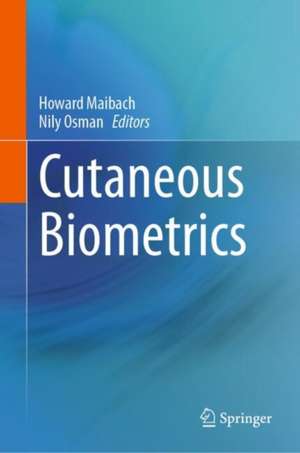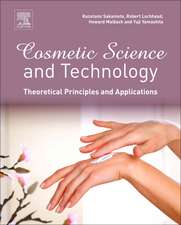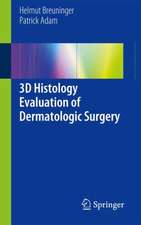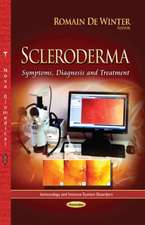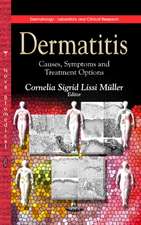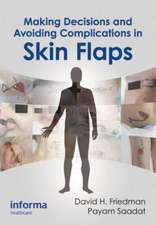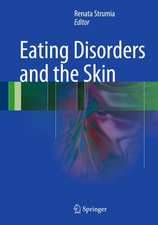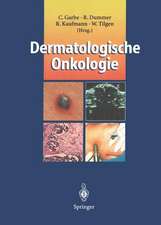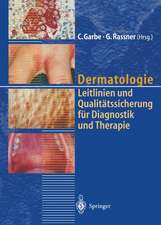Cutaneous Biometrics
Editat de Howard Maibach, Nily Osmanen Limba Engleză Hardback – 14 aug 2024
This book also:
Broadens reader understanding of the importance of creating meaningful dermatological patient outcome measurements and the use of the physician global assessment in a clinical setting to measure and track patient outcomes
Details the guidelines on the measurement of ultraviolet radiation levels in ultraviolet phototherapy
Preț: 2796.39 lei
Preț vechi: 2943.57 lei
-5% Nou
Puncte Express: 4195
Preț estimativ în valută:
535.06€ • 558.72$ • 441.85£
535.06€ • 558.72$ • 441.85£
Carte tipărită la comandă
Livrare economică 11-17 aprilie
Preluare comenzi: 021 569.72.76
Specificații
ISBN-13: 9783319554730
ISBN-10: 3319554735
Pagini: 1090
Dimensiuni: 155 x 235 mm
Ediția:1st ed. 2024
Editura: Springer
Colecția Springer
Locul publicării:Cham, Switzerland
ISBN-10: 3319554735
Pagini: 1090
Dimensiuni: 155 x 235 mm
Ediția:1st ed. 2024
Editura: Springer
Colecția Springer
Locul publicării:Cham, Switzerland
Cuprins
PART
1
Atopic
Conditions.-
New
Topical
Therapeutic
Models
in
Contact
Dermatitis.-
Validation
and
Assessment
Tools
in
Atopic
Dermatitis.-
The
Clinical
Role
of
the
Antecubital
Severity
Score
for
Atopic
Dermatitis.-
Atopic
Dermatis:
Clinical
Use
of
the
Eczema
Area
and
Severity
Scale.-
Atopic
Eczema:
Recent
Developments
in
Testing
of
New
Clinical
Cutcome
Measures.-
PART
2
Rosacea
and
Dermovascular
Diseases.-
Clinical
Assessment
of
Rosacea
Severity.-
Clinical
Profiles
of
Adult
Onset
Henoch-Schoniein
Purpura.-
The
Use
of
Patient's
Self-Assessment
Grading
Scale.-
PART
3
Infections
and
Wound
Healing.-
Assessments
in
Ulcer
and
Wound
Healing.-
Development
of
Skin
Ulcerations.-
Assessment
Scales
for
Scar
formation.-
Necrotizing
Soft
Tissue
Infection
Assessments.-
PART
4
Blistering
and
Bullous
Conditions.-
Development
of
Dermoepidermal
Adhesions.-
Assessment
Tools
for
Phemigus
Vulgaris.-
Treatment
Options
and
Outcomes
for
Phemphigus
Vulgaris.-
Outcome
Measures
for
Autoimmune
Blistering
Disease.-
PART
5
Inflammatory
Skin
Disease.-
The
Reliability
of
Assessment
Tools
in
Psoriasis.-
Assessing
Psoriasis
Patients'
Response
to
Treatment
with
Biologics.-
Developments
in
Topical
Treatments
for
Psoriasis.-
Assessment
Tools
to
Evaluate
the
Severity
of
Disease
in
Psoriasis.-
Usefulness
of
Self
Reporting
Questionaires
for
Psoriasis.-
PART
6
Acne.-
Acne
Severity
Grading
Used
in
a
Clinical
Setting.-
Quality
of
Life
Assessments
for
Patient's
with
Acne.-
Novel
methods
to
improve
clinical
outcomes
and
quality
of
life
for
adolescents
with
acne
vulgaris.-
PART
7
Oncology.-
Clinical
Skills
Assessment
for
Melanoma.-
Advancements
in
the
diagnostic
criteria
for
cutaneous
anaplastic
large
cell
lymphoma.-
Total
Body
Photography
for
Skin
Cancer
Screening.-
Nail
Changes
and
Chemotherapy.-
PART
8
Autoimmune
Conditions.-
Assessing
Clinical
Responsiveness
to
treatment
for
patients
with
dermatomyosositis.-
Measuring
Outcomes
of
Cutaneous
Sarcoidosis.-
Assessment
Tools
for
Alopecia
Areata.-
Assessment
Tools
for
Evaluating
Treatment
Response
in
Patients
with
Chronic
Spontaneous
Urticaria.-
Scoring
and
Disease
Severity
for
Oral
Lichen
Planus.-
Assessment
Tools
for
Measurign
the
Impact
of
Disease
in
Vitiligo
patients.-
PART
9
Metrics,
Statistics
and
Assessments.-
Metrics
and
clinical
relevance
of
percutaneous
penetration
and
lateral
spreading.-
Using
the
physician
global
assessment
in
a
clinical
setting
to
measure
and
track
patient
outcomes.-
The
Importance
of
Creating
Meaningful
Patient
Outcome
Measures
in
Dermatology.-
Number
Needed
to
Treat
as
Derived
by
Ordinal
Scalres.-
Measurements
of
Transepidermal
Water
Loss.-
The
Influences
Affecting
Patient
Discharge.-
Validation
of
a
simplified
provacation
instrument
for
diagnosis
and
threshold
testing
of
symptomatic
dermographism.-
Consumer
Quality
Index
Chronic
Skin
Disease
(CQI-CSD):
a
new
instrument
to
measure
quality
of
care
from
the
patient's
perspective.-
Pharmacometrics
in
Dermatology.-
Guidelines
on
the
measurement
of
ultraviolet
radiation
levels
in
ultraviolet
phototherapy.-
Study
design
in
dermatology.-
Development
and
Validation
of
a
clinical
scale
for
the
evaluation
of
skin
photoaging.-
PART
10
Genetics.-
Improving
Cutaneous
Oncology
Outcomes
With
the
Use
of
Genetics.-
Novel
Genetic
Screening
for
Psoriasis
Patients
to
Perdict
Response
to
Biological
Treatments.
Notă biografică
Dr.
Howard
Maibach
is
an
expert
in
contact
and
occupational
dermatitis
and
sees
patient
at
the
Environmental
Dermatosis
Clinic,
which
is
part
of
the
Dermatology
Clinic.
His
specialty
is
dermatotoxicology,
or
skin
exposure
toxicity;
allergies
and
skin
disorders;
and
dermatopharmacology,
or
the
study
of
medications
for
skin
disorders.
Dr. Maibach has been on the editorial board of more than 30 scientific journals and is a member of 19 professional societies, including the American Academy of Dermatology, San Francisco Dermatological Society, and the Internal Commission on Occupation Health. He is a Professor in the Department of Dermatology at UCSF.
Dr. Maibach has been on the editorial board of more than 30 scientific journals and is a member of 19 professional societies, including the American Academy of Dermatology, San Francisco Dermatological Society, and the Internal Commission on Occupation Health. He is a Professor in the Department of Dermatology at UCSF.
Textul de pe ultima copertă
This
handbook
covers
the
essential
subject
areas
of
cutaneous
biometrics,
including
acne,
aging,
genetics,
eczema,
psoriasis,
atopic
dermatitis,
rosacea,
wound
healing,
and
more.
Erythema
of
rosacea
and
the
risk
of
skin
ulceration
associated
with
oral
nicorandil
therapy
are
covered
in
detail.
Various
areas
of
acne
are
addressed,
including
acne
severity
grading,
the
assessment
of
general
health
and
quality
of
life
in
patients
with
acne,
and
the
effect
of
automated
online
counseling
on
clinical
outcomes
and
quality
of
life
among
adolescents
with
acne
vulgaris.
Other
topics
include
the
development
and
validation
of
a
clinical
scale
for
the
evaluation
of
forearm
skin
photoaging
and
a
scoring
system
for
mucosal
disease
severity.
This
is
an
ideal
reference
for
biomedical
engineering
researchers
and
clinicians
working
in
the
field
of
dermatology
interested
in
a
deeper
understanding
of
cutaneous
biometrics
and
how
it
can
be
applied
to
their
work.
This book also: tial="" subjects="" within="" cutaneous="" biometrics="" ranging="" from="" rosacea="" to="" psoriasis="" acne Broadens reader understanding of the importance of creating meaningful dermatological patient outcome measurements and the use of the physician global assessment in a clinical setting to measure and track patient outcomes
Details the guidelines on the measurement of ultraviolet radiation levels in ultraviolet phototherapy
This book also: tial="" subjects="" within="" cutaneous="" biometrics="" ranging="" from="" rosacea="" to="" psoriasis="" acne Broadens reader understanding of the importance of creating meaningful dermatological patient outcome measurements and the use of the physician global assessment in a clinical setting to measure and track patient outcomes
Details the guidelines on the measurement of ultraviolet radiation levels in ultraviolet phototherapy
Caracteristici
Covers
essential
subjects
within
cutaneous
biometrics
ranging
from
rosacea
to
psoriasis
to
acne
Broadens reader understanding of the importance of creating meaningful dermatological patient outcome measurements and the use of the physician global assessment in a clinical setting to measure and track patient outcomes
Details the guidelines on the measurement of ultraviolet radiation levels in ultraviolet phototherapy
Broadens reader understanding of the importance of creating meaningful dermatological patient outcome measurements and the use of the physician global assessment in a clinical setting to measure and track patient outcomes
Details the guidelines on the measurement of ultraviolet radiation levels in ultraviolet phototherapy
